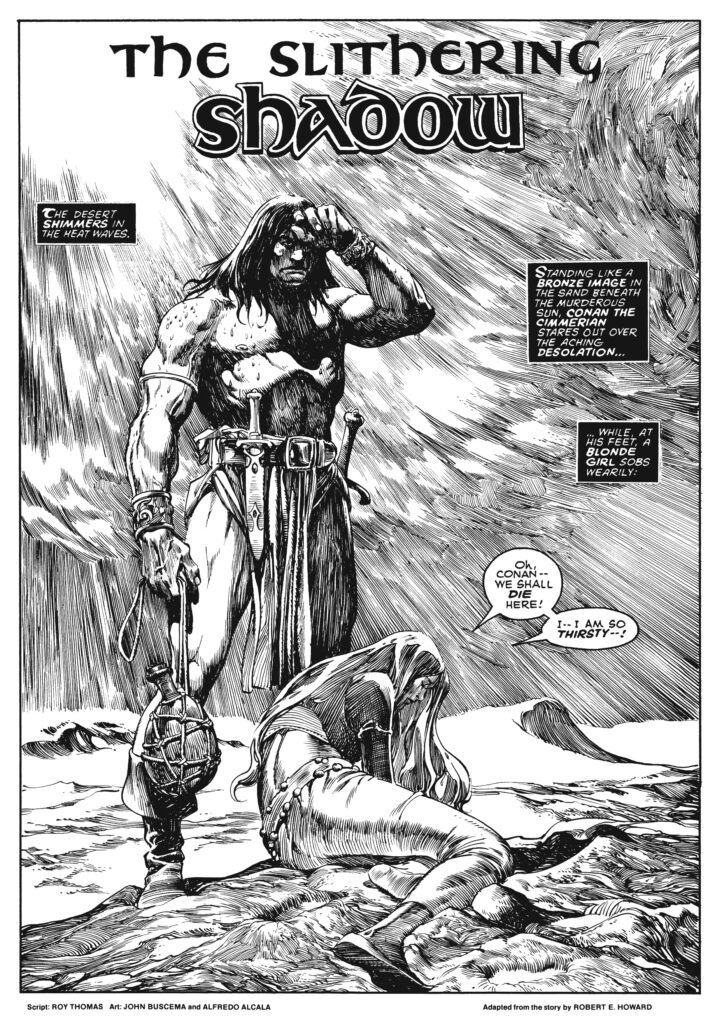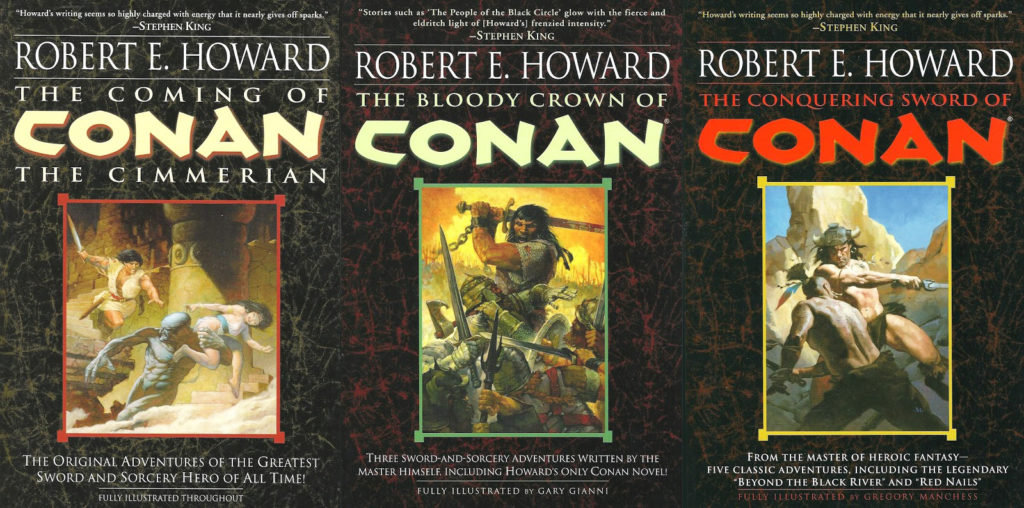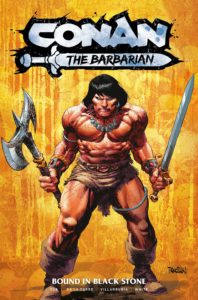Continuing my Conan reread for Cimmerian September, the fifth published Conan story is Xuthal of the Dusk, which arrived in the September 1933 issue of Weird Tales magazine under the renamed title The Slithering Shadow.
With Conan now quite well established in Weird Tales, Howard wastes no time introducing our hero or establishing his iconic appearance. It’s assumed that the reader knows who he is by this point, and when he and a woman named Natala are lost in the scorching desert and almost out of water, the stakes are readily apparent.
The desert shimmered in the heat waves. Conan the Cimmerian stared out over the aching desolation and involuntarily drew the back of his powerful hand over his blackened lips. He stood like a bronze image in the sand, apparently impervious to the murderous sun, though his only garment was a silk loin-cloth, girdled by a wide gold-buckled belt from which hung a saber and a broad-bladed poniard. On his clean-cut limbs were evidences of scarcely healed wounds.
Seeing a location in the distance and not having any other options, Conan hefts Natala into his arms and carries her to find out what’s on the horizon. When they arrive, it’s an imposing and oddly vacant-seeming spot:
Above them the walls towered some thirty feet in height, composed of a smooth greenish substance that shone almost like glass. Conan scanned the parapets, expecting to be challenged, but saw no one. Impatiently he shouted, and banged on the gate with his saber hilt, but only the hollow echoes mocked him.
Inside the city, which they find out is named Xuthal, they discover bodies and assume that they’re dead, but in actual truth they’re sleeping, addicted to the juice of the black lotus, as explained by Thalis, an alluring Stygian who has been imprisoned there:
“You have heard of the black lotus? In certain pits of the city it grows. Through the ages they have cultivated it, until, instead of death, its juice induces dreams, gorgeous and fantastic. In these dreams they spend most of their time. Their lives are vague, erratic, and without plan. They dream, they wake, drink, love, eat and dream again. They seldom finish anything they begin, but leave it half completed and sink back again into the slumber of the black lotus.”
The first chapter is over 7000 words, has a pile of exposition, and is oddly paced. Information on the strange city, its slumbering inhabitants, and the eldritch creature called Thog that lurks in shadows and feeds on victims is presented in a surprisingly sluggish way that makes it difficult for me to get excited about what might come next. When the chapter ends with Thalis suddenly kidnapping Natala, leaving Conan to figure out how to find them, it’s an odd jolt but at least something interesting is happening:
Thalis and Natala had vanished. The tapestry was settling back in place, as if it had been lifted away from the wall. As he gaped bewilderedly, from behind that tapestried wall rang a muffled scream in the voice of the Brythunian girl.
Chapter two is only 1800 words and it follows Thalis as she berates and then tortures Natala, with the Stygian insisting that once Natala is eaten by Thog, Conan will be hers. Robert E. Howard had learned that Farnsworth Wright, the editor of Weird Tales, more readily approved stories with lovely ladies in bondage and/or struck with whips, so this chapter feels like exactly what it is – an indulgent fetish detour to ensure it got published, but the brevity and awkwardness of it all makes it a narrative speed bump instead of anything compelling.
With a hiss of vindictive gratification, Thalis drew back her arm, and Natala shrieked as the cords curled across her loins. The tortured girl writhed, twisted and tore agonizedly at the thongs which imprisoned her wrists. She had forgotten the lurking menace her cries might summon, and so apparently had Thalis.
Thog arrives, attacks Thalis from the shadows and eats her, and Natala is left to gape upon the creature’s terrifying form, which is written with bombast:
The darkness was taking form. Something huge and bulky grew up out of the void. She saw a great misshapen head emerging into the light. At least she took it for a head, though it was not the member of any sane or normal creature. She saw a great toad-like face, the features of which were as dim and unstable as those of a specter seen in a mirror of nightmare. Great pools of light that might have been eyes blinked at her, and she shook at the cosmic lust reflected there. She could tell nothing about the creature’s body. Its outline seemed to waver and alter subtly even as she looked at it; yet its substance was apparently solid enough.
Chapter three takes us back to Conan and Howard unleashes the Cimmerian on guards in Xuthal with a wild amount of violence as he cuts men down like cordwood in his hunt for Natala. My favorite part of this whirling dervish of death is probably here:
A snarl of bloodthirsty gratification hummed in his bull-throat as he leaped, and the first attacker, his short sword overreached by the whistling saber, went down with his brains gushing from his split skull. Wheeling like a cat, Conan caught a descending wrist on his edge, and the hand gripping the short sword flew into the air scattering a shower of red drops. But Conan had not paused or hesitated. A pantherish twist and shift of his body avoided the blundering rush of two swordsmen, and the blade of one, missing its objective, was sheathed in the breast of the other.
The chapter ends with Conan reuniting with Natala and battling Thog. Our Cimmerian hero gets his ass kicked, but delivers even more damage to the freakish monstrosity:
Hilt-deep the saber sank, somewhere below the grisly face, and a convulsive shudder heaved the vast bulk that half enveloped the Cimmerian. With a volcanic burst of contraction and expansion, it tumbled backward, rolling now with frantic haste down the corridor. Conan went with it, bruised, battered, invincible, hanging on like a bulldog to the hilt of his saber which he could not withdraw, tearing and ripping at the shuddering bulk with the poniard in his left hand, goring it to ribbons.
The final chapter is focused on Natala treating Conan’s extensive injuries, finding a magic elixir that helps him recover, and then the two making an awkward escape back out into the desert. As with the first chapter, it rambles and loses much of the momentum and excitement that pulsed through chapter three.
At a hair under 13,000 words this is a long-ish Conan tale compared to others, but the extra word count doesn’t do it any favors. As you can probably tell, I’m not a big fan of this one. There’s all the right ingredients for a classic sword & sorcery tale in here and moments with interesting description and bits of atmosphere that work, but most of it feels unfocused and uninspired.
That said, the comic adaptation in Savage Sword of Conan #20 is stunningly illustrated by John Buscema and Alfredo Alcala, with the artwork enhancing every moment, propelling it past most of the prose’s shortcomings for me:


If you haven’t read the original Conan prose stories, I recommend the Del Rey 3-book set, which has each story unedited and essays that add context around their publication.







 Zub on Amazon
Zub on Amazon Zub on Instagram
Zub on Instagram Zub on Twitter
Zub on Twitter
In this one I really like the concept of the lotus was used and I really like Female Villains as well.